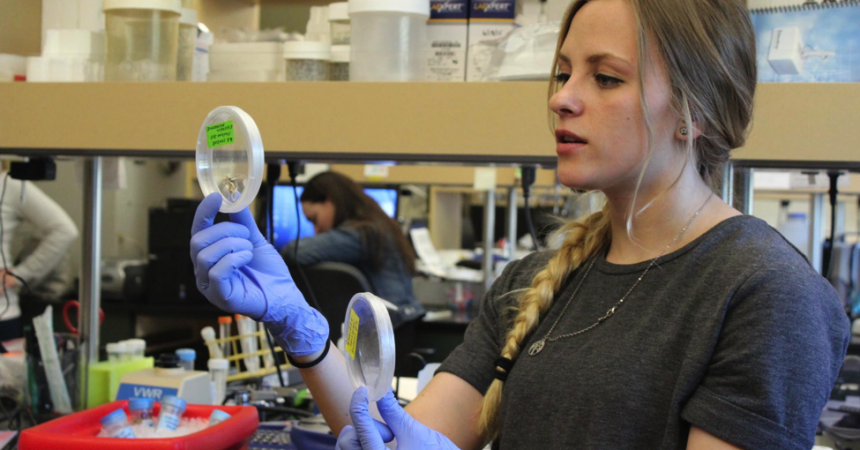Zoo InternQuest is a seven-week career exploration program for San Diego County high school juniors and seniors. Students have the unique opportunity to meet professionals working for the San Diego Zoo, Safari Park, and Institute for Conservation Research, learn about their jobs, and then blog about their experience online. Follow their adventures here on the Zoo’s website!
 This week we met with Oliver Ryder, Leona Chemnick, and Lindsay Sidak-Loftis, three researchers working for the Institute for Conservation Research’s Conservation Genetics department. The study of genetics is a fast paced field, with new technology and discoveries emerging rapidly. Dr. Ryder demonstrated this as he explained that the first human genome was sequenced in 2003. In the following years, improvements in technology have allowed the sequencing process to become more time and cost efficient. Now, researchers aim to sequence the genomes of all 8.7 million known species, an idea that has become possible as this new field grows.
This week we met with Oliver Ryder, Leona Chemnick, and Lindsay Sidak-Loftis, three researchers working for the Institute for Conservation Research’s Conservation Genetics department. The study of genetics is a fast paced field, with new technology and discoveries emerging rapidly. Dr. Ryder demonstrated this as he explained that the first human genome was sequenced in 2003. In the following years, improvements in technology have allowed the sequencing process to become more time and cost efficient. Now, researchers aim to sequence the genomes of all 8.7 million known species, an idea that has become possible as this new field grows.
Why do researchers want to sequence the DNA of so many species? The DNA of animals holds the secrets to their behavior, health, and reproduction, information that is crucial when it comes to conserving species. Within each cell of an animal is the nucleus, which is like a library in that it houses the “books,” or chromosomes, that hold key information. Each chromosome contains long sequences of A,T,C, and G proteins. These four proteins give directions to cells when they are combined in different ways, similar to how the 26 letters of the alphabet form millions of different words. DNA is the instruction manual for cell development. When researchers are able to translate the language of genetics, it is easier to understand a species. Dr. Ryder and his team are working to combine their understanding of genetics and conservation in order to help some of the world’s most critically endangered species.
Although DNA sequencing may sound complicated, the Zoo has applied it to conservation projects multiple times. One of the Zoo’s first genetic projects worked with the critically endangered California condor. Researchers successfully created a much-needed genetic test that determined a condor’s gender. Condors are monomorphic, meaning males and females look exactly the same. This test helped researchers begin to pair mates, but the team still faced the issue of inbreeding. When all the remaining wild condors were first collected, no one knew how related each one was to another. If closely related condors bred, the likeliness of genetic diseases in their offspring increased substantially. The Zoo used DNA fingerprinting to draw a condor family tree. It then used this tree to determine which condors should be paired together. This was the first time genetic testing alone had been used to make conservation recommendations about a species, and the Zoo has continued to use similar methods to help other endangered species.
After hearing about the innovative ways in which the Zoo is utilizing genetics, we tried our hands at DNA analysis. We were shown the many ways in which researchers retrieve an animal’s DNA, from blood and hair to feces. After researchers have retrieved these samples, the DNA is isolated from other materials. A process called PCR duplicates the genes many times, giving researchers ample materials to use for research. Afterwards, these samples are analyzed to find the quality of the genes. Think about how water sticks between your fingers when you pinch and slowly spread them. This is due to surface tension. The machine stretches the sample in a similar way on a microscopic level. Then, it shines light through the liquid DNA is suspended in to see how much DNA the PCR process has generated. With the help of Ms. Sidak-Loftis, we were able to try this method ourselves and see the results graphed on a computer.
After spending a few hours with the Zoo’s Conservation Genetics department, it was easy to see how demanding this job can be. Many aspects of genetics are still a mystery, but the Zoo is working hard to understand the code within DNA so that species can be conserved. Dr. Ryder has seen just how quickly this field changes throughout his time at the Institute, and still continues to be a leader in the application of genetics to conservation. He and his colleagues continue this work for one simple reason- when we begin to understand animals, we also begin to understand ourselves.
Claire, Real World Team
Winter Session, 2017


